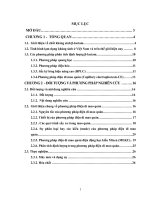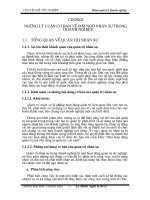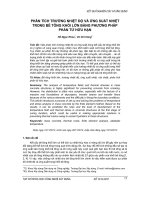- Trang chủ >>
- THPT Quốc Gia >>
- Sinh học
MÔ HÌNH HOÁ CỦA TỪ TRƯỜNG VÀ DÒNG ĐIỆN XOÁY TRONG MÀN CHẮN ĐIỆN TỪ BẰNG PHƯƠNG PHÁP LIÊN KẾT BÀI TOÁN NHỎ
Bạn đang xem bản rút gọn của tài liệu. Xem và tải ngay bản đầy đủ của tài liệu tại đây (656.82 KB, 6 trang )
<span class='text_page_counter'>(1)</span><div class='page_container' data-page=1>
<i>; Email: </i> 7
<b>MODELING OF MAGNETIC FIELDS AND EDDY CURRENT LOSSES IN </b>
<b>ELECTROMAGNETIC SCREENS BY A SUBPROBLEM METHOD </b>
<b>Dang Quoc Vuong* </b>
<i>School of Electrical Engineering, Hanoi University of Science and Technology </i>
ABSTRACT
The aim of this paper is based on a subproblem technique with the magnetic vector potential
formulation to compute magnetic fields, eddy currents and Joule power losses in electromagnetic
screens that are extreamly difficult to perform by a finite element method. The subproblem method
is herein developed for coupling problems in two steps: A problem starting from simplified models
with stranded inductors and thin screen models can be also first considered. Then a correction
problem with the actual volume thin regions is added to correct inaccuracies from previous
problem. All the steps are separately performed with different meshes and geometries, which
facilitates meshing and speeding up the calculation of each problem.
<i><b>Keywords: Magnetic field, Eddy current, Joule power loss, Electromagnetic screen, </b></i>
<i>Magnetodynamics, Subproblem method (SPM), Magnetic vector potential. </i>
<i><b>Received: 18/10/2018; Revised: 16/11/2018; Approved: 28/12/2018</b></i>
<b>MƠ HÌNH HỐ CỦA TỪ TRƯỜNG VÀ DỊNG ĐIỆN XỐY TRONG MÀN </b>
<b>CHẮN ĐIỆN TỪ BẰNG PHƯƠNG PHÁP LIÊN KẾT BÀI TOÁN NHỎ </b>
<b>Đặng Quốc Vương* </b>
<i>Viện Điện - Trường Đại học Bách khoa Hà Nội </i>
TĨM TẮT
Mục đích của bài bài báo được dựa trên phương pháp bài toán nhỏ với cơng thức véc tơ từ thế để
tính tốn từ trường, dịng điện xốy và tổn hao cơng suất trong các màn chắn điện từ, mà khó có
thể thực hiện trực tiếp bằng phương pháp phần tử hữu hạn. Ở đây, phương pháp bài toán nhỏ được
phát triển để liên kết các bài toán theo hai bước: Một bài tốn với mơ hình đơn giản (các cuộn dây
và màn chắn điện từ) được giải trước, sau đó một bài toán hiệu chỉnh được thêm vào để hiệu chỉnh
sai số do bài toán trước gây ra. Tất cả các bước đều được thực hiện độc lập với các lưới và miền
hình học khác nhau, điều này tạo thuận lợi cho việc chia lưới cũng như tăng tốc độ tính tốn của
mỗi một bài tốn.
<i><b>Keywords: Từ trường, dịng điện xốy, tổn hao cơng suất, màn chắn điện từ, bài toán từ động, </b></i>
<i>phương pháp bài toán nhỏ (SPM), véc tơ từ thế. </i>
<i><b>Ngày nhận bài: 18/10/2018; Ngày hoàn thiện: 16/11/2018;Ngày duyệt đăng: 28/12/2018 </b></i>
</div>
<span class='text_page_counter'>(2)</span><div class='page_container' data-page=2>
8
<i>; Email: </i>
INTRODUCTION
Many papers have been applied a subproblem
method (SPM) for computing electromagnetic
fields (eddy current, magnetic flux density
and magnetic filed) and correcting
inaccuracies of fields in the vicinity of thin
shell models in three steps [1-5]. In this paper,
the SPM is extended for coupling subprolems
(SPs) in two steps: A problem starting from
simplified models with stranded inductors
<i>(Fig. 1, top right) and thin screen models can </i>
be also first considered, followed by a
<i>correction problem (Fig. 1, bottom) with the </i>
actual volume thin regions.
The key point of this method allows to benefit
from previous computations instead of
starting a new complete finite element (FE)
solution of thin shell model for any variation
of geometrical or physical characteristics.
Thus, each SP is solved on its own domain
and mesh (Fig. 2), which facilitates meshing
and may increase computational efficiency in
each step.
The method is is validated on a test practical
problem. Its main advantages are pointed out.
<i><b>Figure 1. Decomposition of a complete problem </b></i>
<i>into two subproblems</i>
<i><b>Figure 2. Decomposition of a complete mehs into </b></i>
<i>two sub-meshes: stranded inductor and thin shell </i>
<i>mesh (top), actual volume mesh (bottom).</i>
DEFINTION OF THE SUBPROBLEM
METHOD
<b>Canonical Magnetodynamic problem </b>
<i>A canonical magnetodynamic problem i, to be </i>
<i>solved at step i of the SPM, is defined in a Ω</i><sub>𝑖</sub>,
with boundary 𝑖= Γℎ,𝑖∪ Γ𝑏,𝑖<i>. Subscript i </i>
<i>refers to the associated problem i. The </i>
equations, material relations, boundary
conditions (BCs) and interface conditions
(ICs) of SPs are [5-11]
curl 𝒉<sub>𝑖</sub> = 𝒋<sub>𝑖</sub>, div 𝒃<sub>𝑖</sub>= 0, curl 𝒆<sub>𝑖</sub> = −𝝏<sub>𝑡</sub>𝒃<sub>𝑖</sub>
(1a-b-c)
𝒉<sub>𝑖</sub> = 𝜇<sub>𝑖</sub>−1<sub>𝒃</sub>
𝑖+ 𝒉𝑠,𝑖, 𝒋𝑝= 𝜎𝑝𝒆𝑝+ 𝒋𝑠,𝑝 (2a-b)
𝒏 × 𝒉𝑖 = 𝒋𝑓,𝒊, 𝒏 × 𝒃𝑖|Γ𝑏,𝑖= 𝒇𝑓,𝑖<b> (3a-b) </b>
where 𝒉<sub>𝑖</sub> is the magnetic field, 𝒃<sub>𝑖</sub> is the
magnetic flux density, 𝒆<sub>𝑖</sub> is the electric field,
𝒋𝑖 current density, 𝜇𝑖 is the magnetic
permeability and 𝜎𝑖 is the electric
<i><b>conductivity and n is the unit normal exterior </b></i>
to Ω𝑝
The fields 𝒃𝑠,𝑖 and 𝒋𝑠,𝑝 in (2a-b) are volume
sources (VSs). With the SPM, 𝒉𝑠,𝑖 is also
used for expressing changes of permeability
and 𝒋𝑠,𝑖 for changes of conductivity. For
changes in a region, from 𝜇<sub>𝑝</sub> and 𝜎<sub>𝑝</sub> for
<i>problem (i =p) to 𝜇</i><sub>𝑘</sub> and 𝜎<sub>𝑘</sub><i> for problem (i = </i>
<i>k), the associated VSs </i>𝒃𝑠,𝑖 and 𝒋𝑠,𝑖 are [2-5].
𝒉𝑠,𝑘= (𝜇𝑘−1− 𝜇𝑝−1)𝒃𝑝, (4)
𝒋𝑠,𝑘= (𝜎𝑘− 𝜎𝑝)𝒆𝑝 (5)
for the total fields to be related by 𝒉<sub>𝑝</sub>+ 𝒉<sub>𝑘</sub> =
(𝜇<sub>𝑘</sub>−1(𝒃𝑝+ 𝒃𝑘) and 𝒋𝑝+ 𝒋𝑘 = 𝜎𝑘(𝒆𝑝+ 𝒆𝑘).
=
+
Γ = Γh∪Γ<i>e</i>
Γk=Γh ,k∪Γe,k
Ωc,k
Ω<i>C</i>
<i>c,k</i>
<i>n</i>
<i>n</i>
<i>n</i> t ransit ion layer
act ual volume
air
t hin region(Ωt) Γt
Ω<i>C</i>
<i>c</i>
Ωsor Ωm
<i>js, hs</i>
Ωsor Ωm
<i>γt</i>=<i>γf</i>
<i>...+</i>
t hin shell
</div>
<span class='text_page_counter'>(3)</span><div class='page_container' data-page=3>
<i>; Email: </i> 9
The surface fields 𝒋𝑓,𝑖 and 𝒇𝑓,𝑖 in (3a-b) are
defined possible SSs that account for
particular phenomena occurring in the thin
region between γ<sub>𝑖</sub>+<sub> and γ</sub>
𝑖
−<sub> [2-7]. This is the </sub>
case when some field traces in a SP 𝑝( 𝑖 = 𝑝)
are forced to be discontinuous. The continuity
has to be recovered after a correction via a
SP<sub> 𝑘</sub> (𝑖 = 𝑘). The SSs in SP<sub> 𝑘</sub> are thus to be
fixed as the opposite of the trace solution of
SP<sub> 𝑝</sub> [2-5].
<b>Constraints </b> <b>between </b> <b>thin </b> <b>shell </b> <b>and </b>
<b>correction </b>
The thin shell (TS) model [2-4] written with
the 𝒃<sub>𝑖</sub>-formulation, requires a free (unknown)
discontinuity 𝒂𝑑,𝑡,𝑖 of the tangential
component 𝒂𝑡,𝑖 = (𝒏 × 𝒂𝑖<b>) × 𝒏 of 𝒂</b>𝑖 through
the TS, i.e.
[𝒏 × 𝒂𝑡,𝑖]<sub>Γ</sub>
𝑡,𝑖 = 𝒏 × 𝒂𝑑,𝑡,𝑖 (6)
with a fixed zero value along the TS border
∂Γ<sub>𝑡,𝑖</sub>, which neglects the magnetic flux
entering there. To explicitly express this
discontinuity, one defines [2-5]
𝒂𝑖|Γ𝑡,𝑖 = 𝒂𝑐,𝑖+ 𝒂𝑑,𝑖<b>, (7) </b>
where 𝒂<sub>𝑐,𝑖</sub> is the continuous component of 𝒂<sub>𝑖</sub>.
<b>In addition, the constraint for SPs are </b>
respectively expressed via SSs and VSs. SSs
in (3a-b) are defined via the BCs and ICs of
impedance-type BC combined with
contributions from SP<sub> 𝑖</sub> (𝑖 = 𝑝, 𝑘) [2-5]. One
has [4],
[𝒏 × 𝒉] = [𝒏 × 𝒉𝑝]<sub>Γ</sub>
𝑡,𝑘+ [𝒏 × 𝒉𝑘]Γ𝑡,𝑘 =
−𝜎𝛽𝜕𝑡(2𝒂𝑐,𝑖<b>+</b>𝒂𝑑,𝑖<b>), </b>
(8)𝛽 = 𝛾<sub>𝑖</sub>−1<sub>tanh (</sub>𝑑𝑖𝛾𝑖
2 ) , 𝛾𝑖 =
1+𝑗
𝛿𝑖 ,
𝛿𝑖 = √
2
𝜔𝜇𝜎
<i><b>where d</b>i is the local TS) thickness </i>𝛾𝑖, 𝛿𝑖 is the
skin depth in the TS, 𝜔 = 2𝜋𝑓 with f is the
<i>frequency, j is the imaginary unit. The VSs </i>
can be defined in (4) and (5).
<b>Finite element weak formulation </b>
Equations (1b-c) are fulfilled via the
definition of a magnetic vector potential 𝒂𝑖
and an electric scalar potential 𝜈𝑖, leading to
the 𝒂<sub>𝑖</sub>- formulation, with
curl 𝒂𝑖= 𝒃𝑖, 𝒆𝑖 = −𝝏𝑡𝒂𝑖− grad 𝜈𝑖, (9a-b)
𝒏 × 𝒂𝑖|Γ𝑏,𝑖 = 𝒂𝑓,𝑖. (10)
The weak 𝒃<sub>𝑖</sub>-formulation (in terms of 𝒂<sub>𝑖</sub>) of
SP<sub> 𝑖</sub><i> (i</i>
<i> p, k) is obtained from the weak form </i>of the Ampère equation (1a), i.e. [5] - [11]
(𝜇<sub>𝑖</sub>−1curl 𝒂<sub>𝑖</sub>, curl 𝒂<sub>𝑖</sub>′<sub>)</sub>
Ω𝑖+ (𝒉𝑠,𝑖, curl 𝒂𝑖
′<sub>)</sub>
Ω𝑖
+(𝜎<sub>𝑖</sub>𝜕<sub>𝑖</sub>𝒂<sub>𝑖</sub>, 𝒂<sub>𝑖</sub>′<sub>)</sub>
Ω𝑐,𝑖+ (𝜎𝑖grad 𝜈𝑖, 𝒂𝑖
′<sub>)</sub>
Ω𝑐,𝑖
+< 𝒏 × 𝒉<sub>𝑖</sub>, 𝒂<sub>𝑖</sub>′ <sub>></sub>
Γℎ,𝑖−Γ𝑡,𝑖
+ < [𝒏 × 𝒉<sub>𝑖</sub>]<sub>Γ</sub><sub>𝑡,𝑖</sub>, 𝒂<sub>𝑖</sub>′ ><sub>Γ</sub><sub>𝑡,𝑖</sub>
= (𝒋<sub>𝑖</sub>, 𝒂<sub>𝑖</sub>′<sub>)</sub>
Ω𝑠,𝑖, ∀ 𝒂𝑖
′ <sub>∈ 𝐹</sub>
𝑖1(Ω𝑖) (11)
𝑐,𝑖, gauged in 𝑐,𝑖𝐶 , and containing the basis
functions for 𝒂𝑖 as well as for the test
function 𝒂<sub>𝑖</sub>′<sub> (at the discrete level, this space is </sub>
defined by edge FEs; the gauge is based on
the tree-co-tree technique); (·, ·)<sub></sub> and
< ·, · > respectively denote a volume integral
in and a surface integral on of the
product of their vector field arguments. The
surface integral term on Γℎ,𝑖-Γ𝑡,𝑖 accounts for
natural BCs of type (3a), usually zero.
The term < [𝒏 × 𝒉<sub>𝑖</sub>]<sub>Γ</sub><sub>𝑡,𝑖</sub>, 𝒂<sub>𝑖</sub>′ > in (11) is
defined via (8), that is
< [𝒏 × 𝒉<sub>𝑖</sub>]<sub>Γ</sub><sub>𝑡,𝑖</sub>, 𝒂<sub>𝑖</sub>′ > =
< −𝜎𝛽𝜕𝑡(2𝒂𝑐,𝑖+ 𝒂𝑑,𝑖, 𝒂𝑖′ <b>>, (12)</b>
Once obtained, the TS solution is then
corrected by a correction problem that
overcomes the TS assumption [2-5].
At the discrete level, the source 𝒂𝑝<b>(𝑖 = 𝑝), </b>
initially in mesh of SP𝑢<b> has to be projected in </b>
</div>
<span class='text_page_counter'>(4)</span><div class='page_container' data-page=4>
10
<i>; Email: </i>
sources is crucial for the efficiency of the
method.
<b>Projections of Solutions between Meshes </b>
Some parts of a previous solution 𝒂<sub>𝑝</sub> serve as
sources in a subdomain 𝑝𝑘 of the
current problem SP𝑘. At the discrete level,
this means that this source quantity 𝒂<sub>𝑝</sub> has to
be expressed in the mesh of problem SP𝑘,
while initially given in the mesh of problem
SP𝑝. This can be done via a projection method
[2-4] of its curl limited to <sub>𝑘</sub>, i.e.
(curl 𝒂𝑝, curl 𝒂𝑘′)<sub>Ω</sub>
𝑘= (curl 𝒂𝑘, curl 𝒂𝑘
′<sub>)</sub>
Ω𝑘,
∀ 𝒂<sub>𝑘</sub>′ ∈ 𝐹<sub>𝑘</sub>1(Ω𝑘) (10)
where 𝐹<sub>𝑘</sub>1(Ω𝑘) is a gauged curl-conform
<i>function space for the k-projected source </i>𝒂𝑝
(the projection of 𝒂<sub>𝑝</sub> on mesh SP<sub>𝑘</sub>) and the
test function 𝒂𝑘′.
APPLICATION TEST
The test problem is based on TEAM problem
21 (2D-model, page 4) [12], with two
inductors and a magnetic plate/screen (Fig. 3),
<i>with f = 50Hz, 𝜇</i>𝑟 = 200, 𝜎 = 6.484MS<sub>m</sub>.
<i><b>Figure 3. Geometry of TEAM problem 21.</b></i>
The problem is considered in two steps: the
distribution of magnetic flux density
generated by imposed electric currents
flowing in stranded inductors is pointed out in
<i><b>Figure 4 (top). Then volume correction </b></i>SP𝑘
replaces the TS plate with classical volume
FEs covering the plates and their
neighborhood, with an adequate refined mesh,
that does not include inductors and TS plate
<i>anymore (Fig. 4, bottom), to correct errors </i>
arising from the TS plate [2-4]. The
distribution of eddy current density along the
volume correction is shown in Figure 5.
The computed results of magnetic flux
density and Joule power loss in the plate
checked to be close to the measured results
for different parameters of exciting currents
(proposed by author in [12]) are shown in
Figure 6 and Figure 7. The everage errors
between computed and measured methods on
the magnetic flux density are lower than 7%,
and are lower 10% for Joule power losses. It
can be shown that there is a very good
agreement between two methods.
This test problem has been successfully
applied to standardize the type and material of
the plate in practice.
<i><b>Figure 4. Magnetic flux density for stranded </b></i>
<i><b>inductors and TS plate </b></i> SP𝑝<i><b> (top), the correction </b></i>
SP𝑘<i><b> with an actual screen (bottom) (𝜇</b></i>𝑟=
</div>
<span class='text_page_counter'>(5)</span><div class='page_container' data-page=5>
<i>; Email: </i> 11
<i><b>Figure 5. Eddy current along the plate/screen for </b></i>
<i> the correction SP</i>𝑘<i><b> with an actual creen (𝜇</b></i>𝑟=
200, 𝜎 = 6.484MS<sub>m</sub><i>, 𝑓 = 50Hz, 𝑑 = 10mm). </i>
<i><b>Figure 6. Comparison of the computed and </b></i>
<i>measured Joule power loss in the plate (</i>𝜇𝑟=
100, 𝜎 = 6.484MS<sub>m</sub><i>, 𝑓 = 50Hz, 𝑑 = 5mm). </i>
<i><b>Figure 7. Comparison of the computed and </b></i>
<i>measured magnetic flux density in the plate </i>
<i>(</i>𝜇𝑟= 100, 𝜎 = 6.484MS<sub>m</sub> <i>, 𝑓 = 50Hz, 𝑑 = 5mm). </i>
CONCLUSIONS
All the steps of the subproblem technique
have been presented by coupling SPs in two
steps. The accuracies of magnetic flux density
and Joule power losses are successfully
obtained in the plate/screen. In particular,
they have been checked to be close with the
measured results [12]. Moreover, The
correction is also directly linked to the
volumic mesh of the plate/screen and its
eneighboring, that permit to reduce the
meshing efforts. The method allows to use
previous local meshes instead of starting a
new complete mesh for any postion of the
plate/screen.
REFERENCES
1. Vuong Q. Dang, P. Dular R.V. Sabariego, L.
<i>Krähenbühl, C. Geuzaine, “Subproblem Approach </i>
<i>for Modelding Multiply Connected Thin Regions </i>
<i>with an h-Conformal Magnetodynamic Finite </i>
<i>Element Formulation”, in EPJ AP., vol. 63, </i>
no.1, 2013.
2. Vuong Q. Dang, P. Dular, R.V. Sabariego, L.
<i>Krähenbühl, C. Geuzaine, “Subproblem approach </i>
<i>for </i> <i>Thin </i> <i>Shell </i> <i>Dual </i> <i>Finite </i> <i>Element </i>
<i>Formulations,” IEEE Trans. Magn., vol. 48, no. 2, </i>
pp. 407–410, 2012.
3. P. Dular, Vuong Q. Dang, R. V. Sabariego,
<i>L. Krähenbühl and C. Geuzaine, “Correction of </i>
<i>thin shell finite element magnetic models via a </i>
<i>subproblem method,” IEEE Trans. Magn., Vol. 47, </i>
no. 5, pp. 158 –1161, 2011.
4. Dang Quoc Vuong <i>“Modeling </i> <i>of </i>
<i>Electromagnetic </i> <i>Systems </i> <i>by </i> <i>Coupling </i> <i>of </i>
<i>Subproblems – Application to Thin Shell Finite </i>
<i>Element Magnetic Models,” PhD. Thesis </i>
<i>(2013/06/21), University of Liege, Belgium, </i>
Faculty of Applied Sciences, June 2013.
<i>5. Dang Quoc Vuong “A Subproblem Method for </i>
<i>Accurate Thin Shell Models between Conducting </i>
<i>and Non-Conducting Regions,” The University of </i>
Da Nang Journal of Science and Technology, no
12 (109).2016.
6. Tran Thanh Tuyen, Dang Quoc Vuong, Bui
<i>Duc Hung and Nguyen The Vinh “Computation of </i>
<i>magnetic fields in thin shield magetic models via </i>
<i>the Finite Element Method,” The University of Da </i>
Nang Journal of Science and Technology, no 7
(104).2016.
7. Dang Quoc Vuong, Bui Duc Hung and Khuong
<i>Van Hai “Using Dual Formulations for </i>
<i>Correction of Thin Shell Magnetic Models by a </i>
<i>Finite </i> <i>Element </i> <i>Subproblem </i> <i>Method,” </i> The
University of Da Nang Journal of Science and
Technology, no 6 (103).2016.
<i>8. Dang Quoc Vuong “Tính toán sự phân bố của </i>
<i>từ trường bằng phương pháp miền nhỏ hữu hạn - </i>
0
50
100
150
200
250
300
350
400
10 15 20 25 30 35 40 45 50
Jo
u
le
p
o
w
er
l
o
ss
(
W
)
Exciting currents (A)
Measured results
Calculated results
0
0.5
1
1.5
2
10 15 20 25 30 35 40 45 50
M
ag
n
et
ic
f
lu
x
d
en
si
ty
(
1
0
-3 T
)
</div>
<span class='text_page_counter'>(6)</span><div class='page_container' data-page=6>
12
<i>; Email: </i>
<i>Ứng dụng cho mơ hình cấu trúc vỏ mỏng,” Tạp chí </i>
Khoa học và Cơng nghệ, Đại học Công nghiệp Hà
Nội, số 36, trang 18-21, 10/2016.
<i>9. Dang Quoc Vuong “An iterative subproblem </i>
<i>method for thin shell finite element magnetic </i>
<i>models," The University of Da Nang Journal of </i>
Science and Technology, no 12 (121).2017.
10. Tran Thanh Tuyen and Dang Quoc Vuong,
<i>“Using a Magnetic Vector Potential Formulation </i>
<i>for Calculting Eddy Currents in Iron Cores of </i>
<i>Transformer by A Finite Element Method,” The </i>
University of Da Nang Journal of Science and
Technology, no 3 (112), 2017 (Part I).
11. S. Koruglu, P. Sergeant, R.V. Sabarieqo,
<i>Vuong. Q. Dang, M. De Wulf “Influence of </i>
<i>contact resistance on shielding efficiency of </i>
<i>shielding gutters for high-voltage cables,” IET </i>
Electric Power Applications, Vol.5, No.9, (2011),
pp. 715-720.
</div>
<!--links-->
Nghiên cứu xác định tổng số và tổng dạng asen trong một số hải sản bằng phương pháp trắc quang
- 83
- 767
- 3








